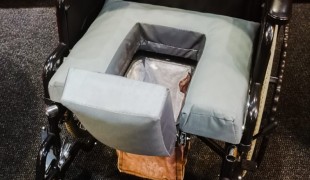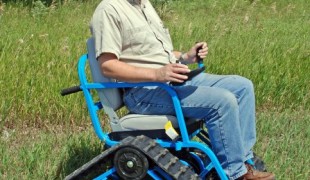- 4428
- 410
- 6
- 6
- 0
- Help Ukraine
About the solution
Here are some of Peter’s solutions:
A system was develop in order for Peter’s bathroom door to open automatically for him when he approaches it and the lights turn on without him having to flick a switch.
“What I did was I used an ultra sound PIR. I design it and my nephew helps me build it”. Running on a simple electric motor, the sliding door would gently fall back when the sensors were activated. They are also programmed not to register anyone below a certain height, to prevent Peter’s dogs constantly triggering the system.
Peter has done some very smooth tweaks to the back of his wheelchair to improve both his safety and that of his two dogs when he goes out to walk them.
He has installed a series of lights (red, blue and white) that light up in slow succession. “If you approach a car that is parked on the pavement and you need to go out onto the road and drive around that car; it’s behind you that you are vulnerable. And it happens a lot.” The choice of colors is not incidental either. Himself a driver, Peter is well aware that whilst people’s attention drifts whilst they’re at the wheel, drivers react instinctively to brake lights (red) up ahead or emergency services (blue).
Peter also got a thin triangular frame, with similar lights, which he can fix to the back of his chair for further visibility, especially when in a crowded space like a shopping mall. “It makes people notice you. They maybe have a laugh at me but I don’t care. The point is no-one’s falling over me anymore”.
Adapted from: http://bit.ly/2gP5Y7E
What about you, do you have any solutions? Please share them with the Patient Innovation community!
这些解决方案不应包括使用药物,化学品或生物制品(包括食品);创伤性设备;冒犯性的,商业或内在危险的内容。该解决方案未经医学验证。请谨慎进行!如果您有任何疑问,请咨询健康专家。
DISCLAIMER: This story was written by someone who is not the author of the solution, therefore please be advised that, although it was written with the utmost respect for the innovation and the innovator, there can be some incorrect statements. If you find any errors please contact the patient Innovation team via info@patient-innovation.com
-
-
370
-
0
-
3906

The PARA-TUBE
(SELF)-CARE: USING THE TOILET: Using the toilet independently
MOVING IN A WHEELCHAIR: Moving using a wheelchair.
Bone Disorders (Decalcification, Bone Deformity, Bone Fracture, Bone Infection)
Spinal Cord and Nerve Root Disorders
Walking Aid (wheelchair/walker/crutches)
Assistive Daily Life Device (to help ADL)
Difficulty walking or moving
Gait abnormalities (e.g., walking difficulties, unsteady gait)
Difficulty coordinating movements
Stiffness or rigidity (difficulty moving)
Paralysis of the legs and lower body
Muscle weakness
Limited range of motion
Muscle pain or stiffness
Muscle cramps or spasms
Promoting self-management
Maintaining Balance and Mobility
Preventing (Vaccination, Protection, Falls, Research/Mapping)
Neurology
Orthopedics
Physical Medicine and Rehabilitation
Rheumatology
South Africa
-
-
-
342
-
0
-
4578

Step articulated and mobile
MOVING IN A WHEELCHAIR: Moving using a wheelchair.
Traveling
Urban exploration
Paralysis
Assistive Daily Life Device (to help ADL)
Walking Aid (wheelchair/walker/crutches)
Restoring mobility
Promoting self-management
Managing Neurological Disorders
Building Supportive Community Relationships
Promoting inclusivity and social integration
Recovering from Traumatic Injuries
Maintaining Balance and Mobility
To improve Treatment/Therapy
Raise awareness
Caregiving Support
Neurology
Orthopedics
Rheumatology
Portugal
-
-
-
414
-
0
-
6274

Parents create a track-chair for their paralysed son
MOVING IN A WHEELCHAIR: Moving using a wheelchair.
CAREGIVING
Paralysis
Neuromuscular Disorders
Walking Aid (wheelchair/walker/crutches)
Assistive Daily Life Device (to help ADL)
Gait abnormalities (e.g., walking difficulties, unsteady gait)
Difficulty coordinating movements
Stiffness or rigidity (difficulty moving)
Paralysis of the legs and lower body
Muscle weakness
Loss of balance
Promoting inclusivity and social integration
Maintaining Balance and Mobility
Preventing (Vaccination, Protection, Falls, Research/Mapping)
Caregiving Support
Neurology
Neurosurgery
Orthopedics
Rheumatology
United States
-
 zh
zh